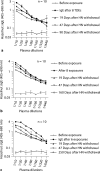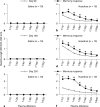Long-term characteristics of hazelnut allergy in an adjuvant-free mouse model
- PMID: 20145410
- PMCID: PMC2895740
- DOI: 10.1159/000283028
Long-term characteristics of hazelnut allergy in an adjuvant-free mouse model
Abstract
Background: Clinically it is recognized that tree nut allergies such as hazelnut allergy are not usually outgrown. Specific mechanisms underlying the persistence of such food allergies are incompletely understood. Here we studied the natural history and the long-term immune and clinical characteristics of hazelnut allergy in an adjuvant-free mouse model.
Methods: BALB/c mice were sensitized to hazelnut protein using a transdermal sensitization protocol that does not use adjuvant. After establishing sensitization, exposure to hazelnut was withdrawn for 3, 5 or 8 months. The fate of circulating IgE antibodies was monitored. Subsequently, mice were given booster exposures and examined for memory IgE antibody and spleen cell IL-4 responses. Clinical characteristics and hypothermia responses upon oral allergen challenge were studied.
Results: Upon allergen withdrawal, circulating hazelnut-specific IgE antibody levels began to drop. Nevertheless, IgE responses once established remained at significantly high levels for up to 8 months (the last time point studied) despite withdrawal of allergen exposure. Memory IgE responses to booster exposures were robust after 3, 5 or 8 months of allergen withdrawal. Furthermore, significant clinical reactivity to oral hazelnut challenge, and hypothermia responses were demonstrable at each of these time points. Long-lasting spleen cell memory IL-4 responses to hazelnut were detectable in these mice explaining the mechanism of sustenance of IgE responses and clinical sensitization.
Conclusions: Hazelnut allergy once established persists for long periods, despite withdrawal of allergen exposure, due to long-lasting, memory IgE and IL-4 responses.
2010 S. Karger AG, Basel.
Figures




Similar articles
-
An adjuvant-free mouse model of tree nut allergy using hazelnut as a model tree nut.Int Arch Allergy Immunol. 2007;144(3):203-10. doi: 10.1159/000103993. Epub 2007 Jun 15. Int Arch Allergy Immunol. 2007. PMID: 17570928
-
Hazelnut Allergy: evidence that hazelnut can directly elicit specific IgE antibody response via activating type 2 cytokines in mice.Int Arch Allergy Immunol. 2005 Aug;137(4):295-302. doi: 10.1159/000086423. Epub 2005 Jun 17. Int Arch Allergy Immunol. 2005. PMID: 15970636
-
Young infants with atopic dermatitis can display sensitization to Cor a 9, an 11S legumin-like seed-storage protein from hazelnut (Corylus avellana).Pediatr Allergy Immunol. 2011 Mar;22(2):196-201. doi: 10.1111/j.1399-3038.2010.01088.x. Pediatr Allergy Immunol. 2011. PMID: 20579306
-
Component-Resolved Diagnosis of Hazelnut Allergy in Children.Nutrients. 2021 Feb 16;13(2):640. doi: 10.3390/nu13020640. Nutrients. 2021. PMID: 33669377 Free PMC article. Review.
-
Hazelnut Allergens: Molecular Characterization, Detection, and Clinical Relevance.Crit Rev Food Sci Nutr. 2016 Nov 17;56(15):2579-2605. doi: 10.1080/10408398.2013.826173. Crit Rev Food Sci Nutr. 2016. PMID: 25751378 Review.
Cited by
-
An adjuvant free mouse model of oral allergenic sensitization to rice seeds protein.BMC Gastroenterol. 2011 May 23;11:62. doi: 10.1186/1471-230X-11-62. BMC Gastroenterol. 2011. PMID: 21605393 Free PMC article.
-
The Role of Skin Barrier in the Pathogenesis of Food Allergy.Children (Basel). 2015 Sep 2;2(3):382-402. doi: 10.3390/children2030382. Children (Basel). 2015. PMID: 27417371 Free PMC article. Review.
-
AllerML: markup language for allergens.Regul Toxicol Pharmacol. 2011 Jun;60(1):151-60. doi: 10.1016/j.yrtph.2011.03.006. Epub 2011 Mar 21. Regul Toxicol Pharmacol. 2011. PMID: 21420460 Free PMC article.
-
Murine models for mucosal tolerance in allergy.Semin Immunol. 2017 Apr;30:12-27. doi: 10.1016/j.smim.2017.07.007. Epub 2017 Aug 12. Semin Immunol. 2017. PMID: 28807539 Free PMC article. Review.
-
Mechanisms of Wheat Allergenicity in Mice: Comparison of Adjuvant-Free vs. Alum-Adjuvant Models.Int J Mol Sci. 2020 May 1;21(9):3205. doi: 10.3390/ijms21093205. Int J Mol Sci. 2020. PMID: 32369940 Free PMC article.
References
-
- Bernhisel-Broadbent J, Dintzis HM, Dintzis RZ, Sampson HA. Allergenicity and antigenicity of chicken egg ovomucoid (Gal d III) compared with ovalbumin (Gal d I) in children with egg allergy and in mice. J Allergy Clin Immunol. 1994;93:1047–1059. - PubMed
-
- Sicherer SH, Sampson HA. Food allergy: recent advances in pathophysiology and treatment. Annu Rev Med. 2009;60:261–277. - PubMed
-
- Sicherer SH, Furlong TJ, Munoz-Furlong A, Burks AW, Sampson HA. A voluntary registry for peanut and tree nut allergy: characteristics of the first 5,149 registrants. J Allergy Clin Immunol. 2001;108:128–132. - PubMed
-
- Host A, Halken S, Jacobsen HP, Christensen AE, Herskind AM, Plesner K. Clinical course of cow's milk protein allergy/intolerance and atopic diseases in childhood. Pediatr Allergy Immunol. 2002;13(suppl 15):23–28. - PubMed
Publication types
MeSH terms
Substances
LinkOut - more resources
Full Text Sources
Medical

